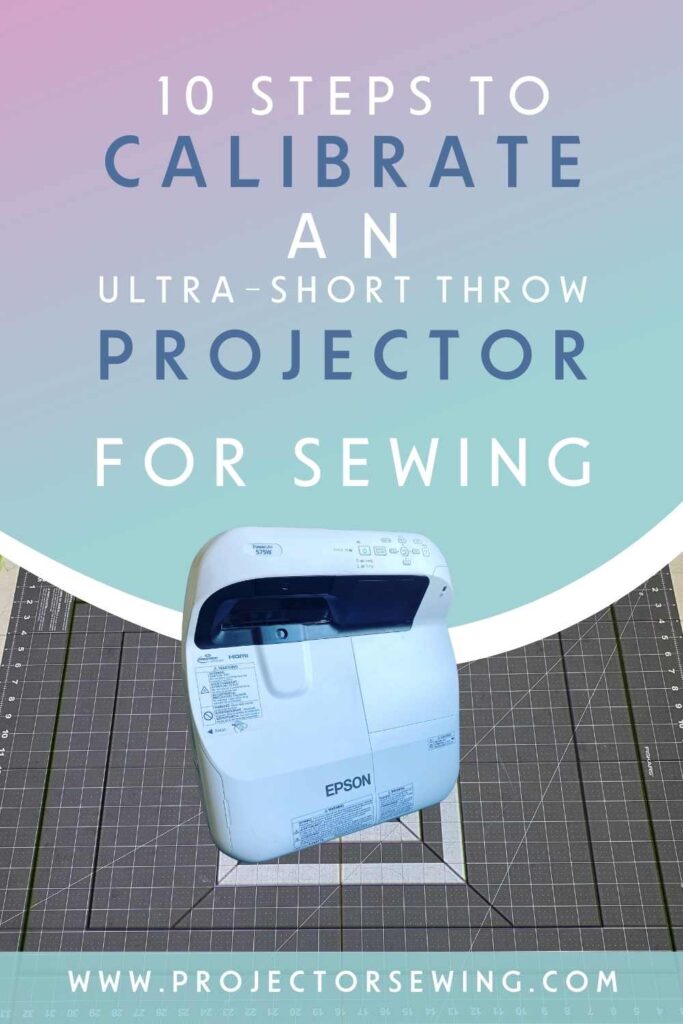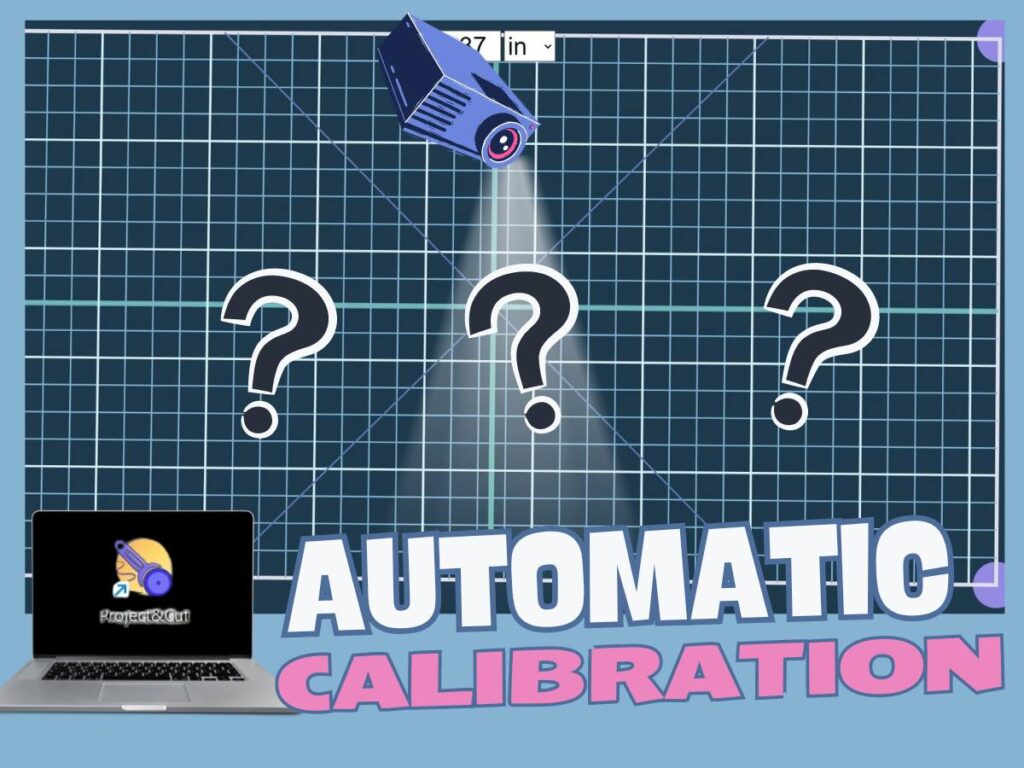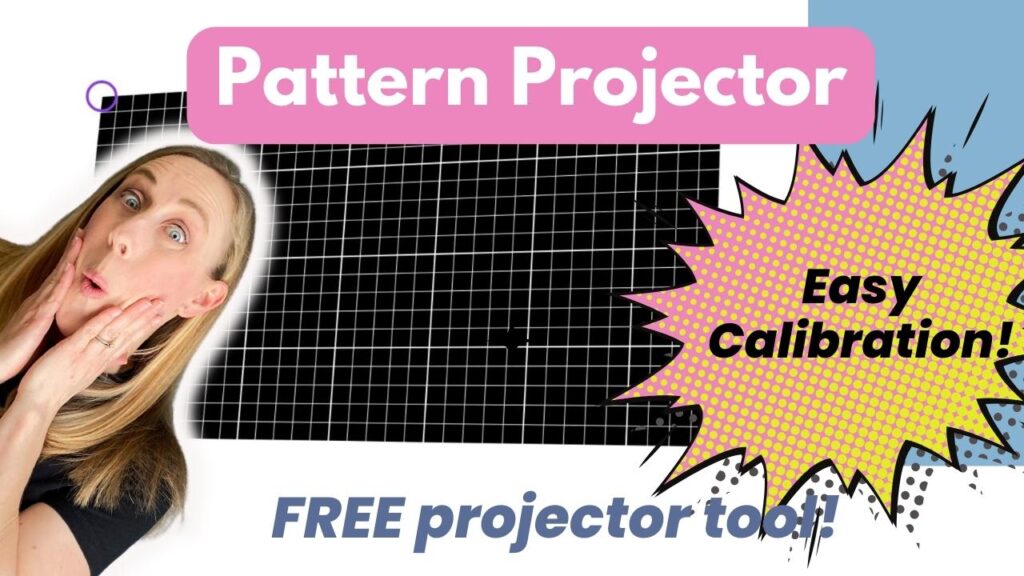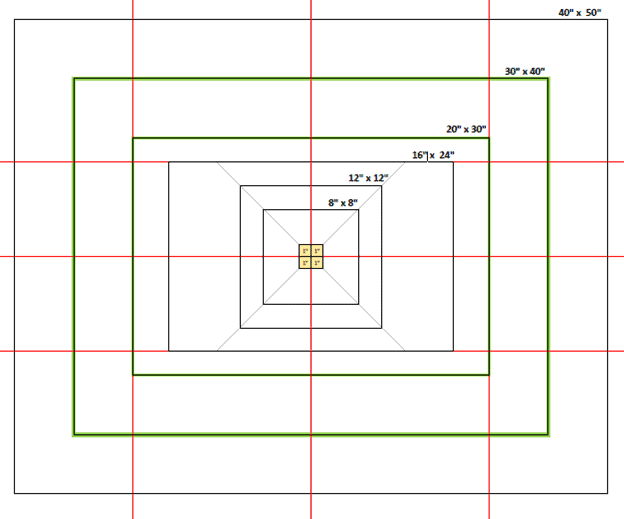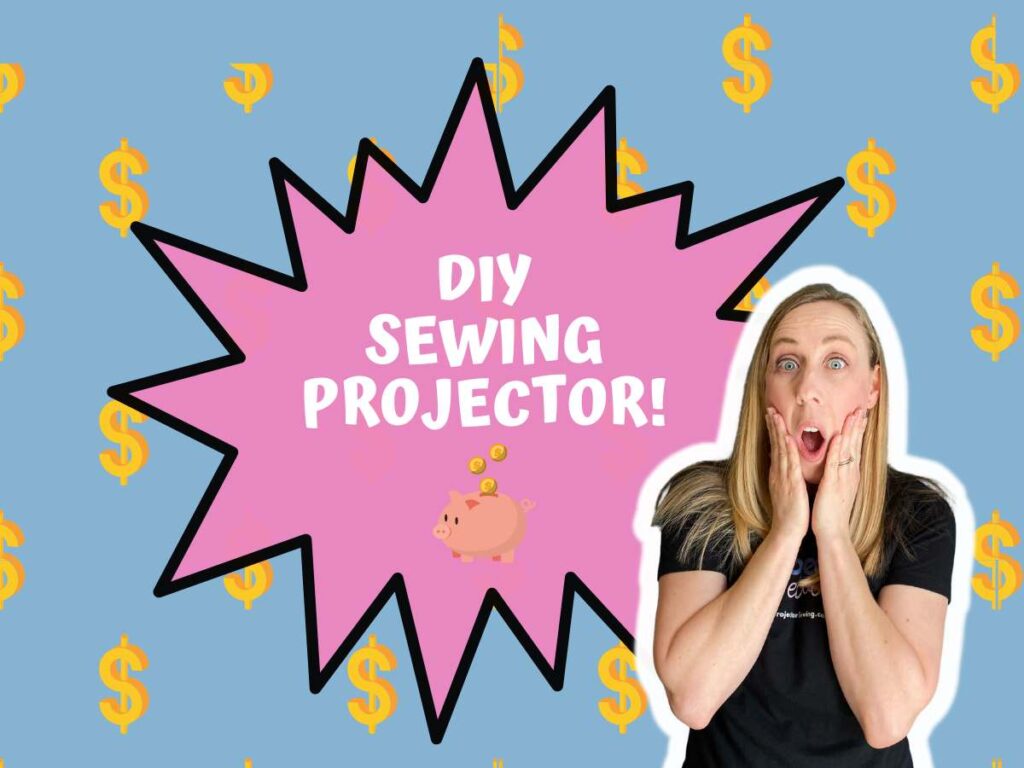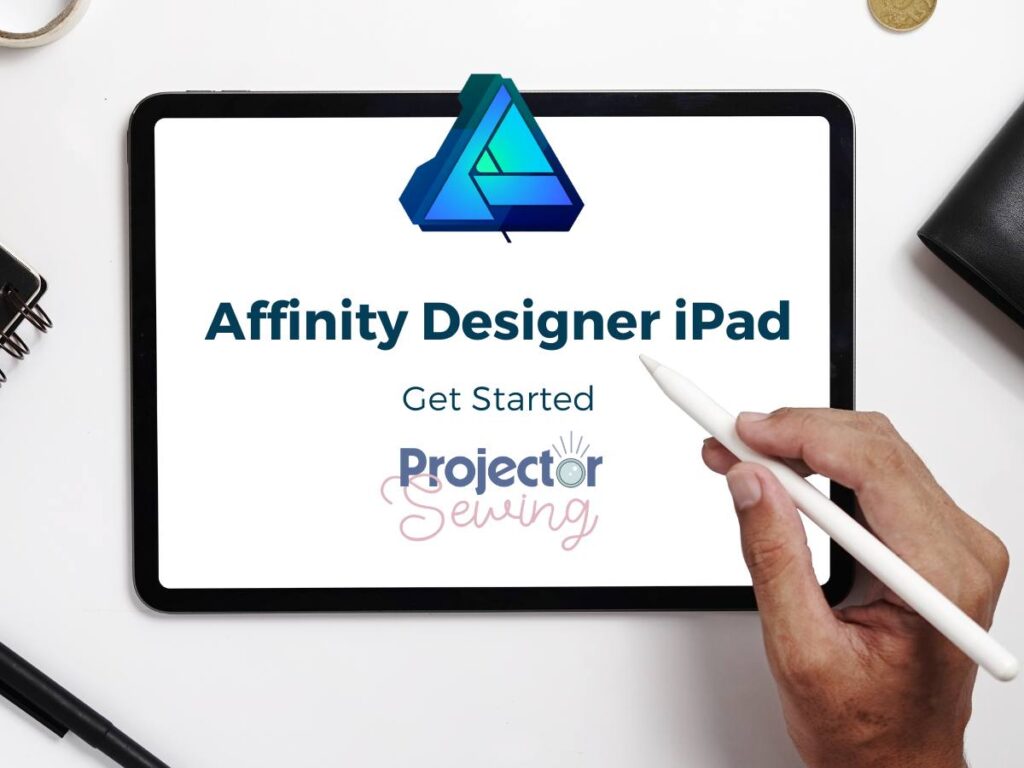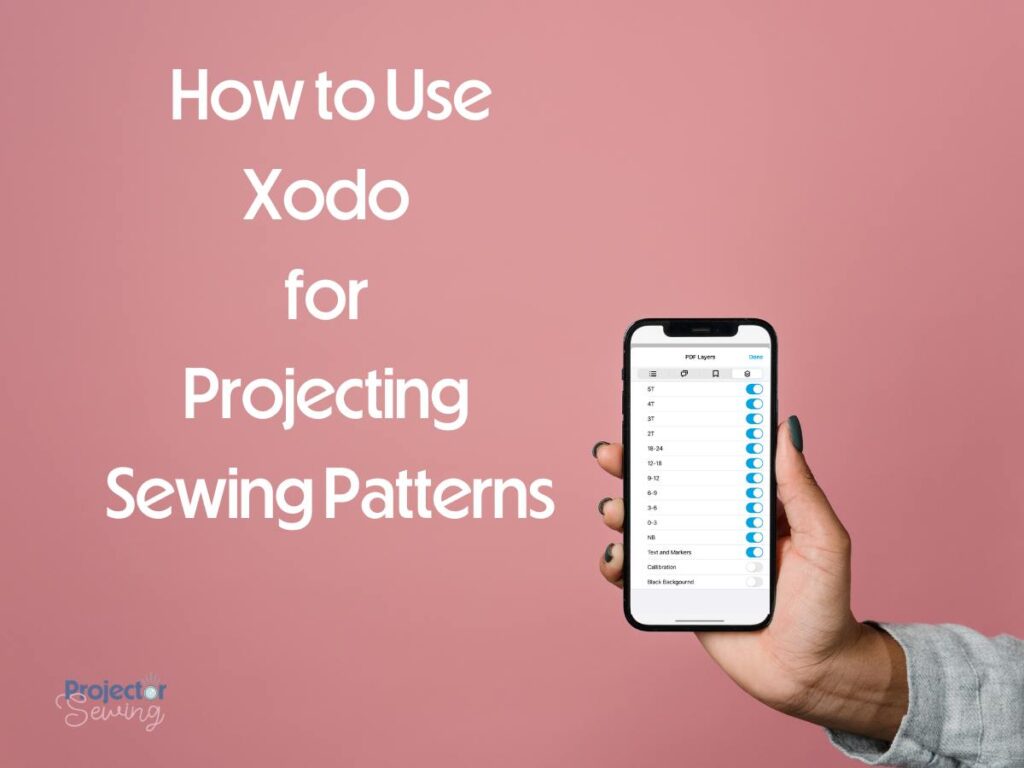Last updated on November 28th, 2023 at 01:21 pm
*This post may contain affiliate links and we may earn a small commission if you click on them.
Calibration. That is a scary word for many who are just joining the sewing with projectors world. It shouldn’t be! I will walk you through step-by-step to help you get calibrated and back to sewing in no time!
I often hear people say, “I’m too nervous to get started!”. Just jump in and give it a try. If you follow the steps, you will get calibrated in no time.
For most people you will only need to calibrate your projector one time and that is it!
Learn better by watching a video? Then checkout the YouTube video below or click HERE to watch on YouTube!
What is Calibration?
Calibration simply means that the image projected onto your cutting mat is “actual size”. In other words, the 1 inch (or 4cm) square on your pattern is actually that size in your projected image.
Calibration does not “change” your projector in anyway. It ensures that the image is level to the lens and cutting surface. When you are finished calibrating you will have a zoom percentage that you will use every time you open Adobe Reader DC. (If you are using different programs each time, you will need a zoom percentage for each program.)
Calibration is an essential step and patterns will not cut out correctly without it. Don’t skip any steps! Skipping steps will add to your frustration.
Want step-by-step guidance on choosing a projector, mount, setting it up, calibrating and more? Then, check out the complete projector confidence course!
- What is Calibration?
- Prepare for Calibration
- Setup and Calibration Video
- Step 1: Remove Projector from Box and Plug In
- Step 2: Reset Projector to Default Settings
- Step 3: Connect Your Projector to Your Computer
- Step 4: Display Computer Screen on Projector
- Step 5: Prepare to Calibrate by “Mounting” Your Projector
- Step 6: Adjust Image Size and Orientation
- Step 7: Open Calibration Document and Focus Image
- Step 8: Square Image with Physical Tilts and Adjustments
- Step 9: Zoom in Adobe
- Step 10: Note Zoom % and Record Calibration
- Ready to Cut!
- Maintenance of Your Projector
- Conclusion
Prepare for Calibration
Essential Programs
You will need a program that can read PDF files and access layers for pattern projection. No, you cannot use a USB drive and plug it into your projector expecting it to display your patterns. That’d be great if someone invented a sewing projector that did this!
What program is best for you depends on your end goal. For those on the computer and just starting out, I recommend Adobe Acrobat Reader DC. It is a free program for both Mac and PC users. I’ve written how to download and setup Adobe in this article.
Mobile and tablet users will need to use Xodo to project PDF files from a phone. Xodo is a free app that can be downloaded from the Apple or Google Play stores. I’ve gone over the important aspects of using a phone and tablet to project patterns here. Affinity Designer is another program that some tablet users enjoy using. It is not free, but gives more options.
Setup Adobe Preferences
Simple adjustments in Adobe will allow you to take advantage of full screen mode. Before going to full screen mode, go to Edit < Preferences (Windows) or Adobe Menu > Preferences (Mac). Click on Full Screen and turn off “Fill one page at a time”.
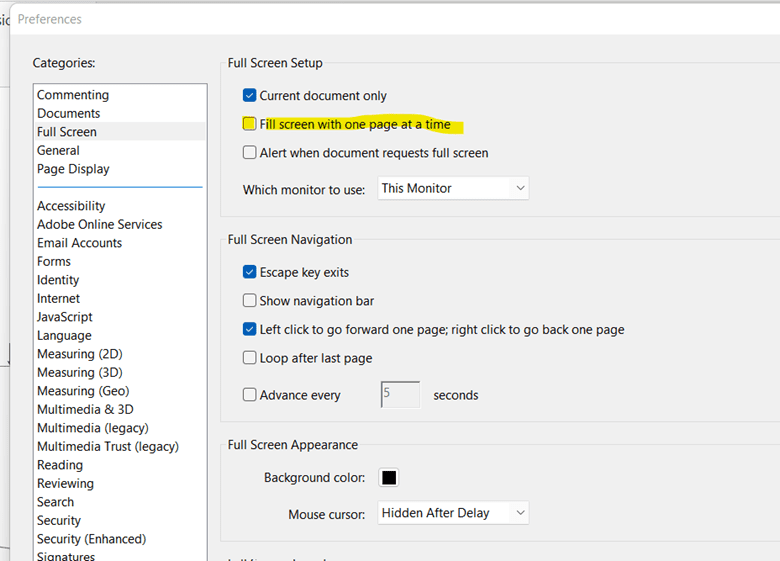
Now you can go between Full Screen mode by pressing Control+L (Windows) or Command+L (Mac). Your zoom percentage will not change when you go to full screen mode.
*Note that the entire calibration document will most likely not fit in your projection area. Find the center of the document and center it on your cutting grid.
Calibration Tool
You will need a calibration file to help you correctly calibrate your sewing projector. If you don't already have one, download the free calibration document provided below (Thanks to Sasha Sewist from the Projectors for Sewing FaceBook group). There are two different documents: Imperial (inches) and Metric (centimeters). Download the units that your cutting mat will match. Save it to your computer.
Open it on your computer, tablet, or phone using Adobe Reader DC (free), Affinity Designer (paid, mobile), Xodo (free, mobile), or Adobe illustrator (Paid). Do NOT open and calibration from your internet browser (i.e. Chrome). If you are using a phone or tablet you will need to download a PDF reader that does layers such as Xodo. (Layers are needed for patterns, not for the calibration tool itself.)
Flat Surface
Having a flat surface will make your calibration process so much smoother! Whether you are cutting on a table or floor, you need it to be even all the way across your cutting mat. I do not recommend cutting on a folding table with a seam down the middle. Uneven surfaces, such as tile, can create complications. Add a piece of drywall, wood, sheet metal, or MDF under your cutting mat to make it even if necessary. Uneven surfaces will create image distortion and throw your cutting lines off.
Troubleshooting Tip: Add a piece of drywall, wood, sheet metal, or MDF under your cutting mat to make the surface even! Remember to always use the same setup when you are projecting patterns.
Tape Measure
Grab a tape measure to have on hand! A tape measure will make it easy to check the measurements of lines and boxes as you calibrate.
Calibration Grid Mat
In order to calibrate using the calibration tool (below), you will need a mat to calibrate against. Most of us already have a cutting mat with a grid on it. You need a large grid to calibrate against for best results. I recommend a cutting mat at least A1 size or 36 inches x 24 inches. Large mats that are A0 sized are great for ultra short throw and short throw projectors that will create larger image sizes. This is the one I have and it works great! If you don’t have one yet, I highly recommend getting one before continuing on.
- ARTS AND CRAFTS STAPLE: Extra large...
- PRECISION ART SUPPLIES: Great for sewing,...
- LONG LASTING AND RELIABLE: Self-healing...
- QUALITY TOOLS FOR ARTS AND CRAFTS: From...
Last update on 2024-05-12 / Affiliate links / Images from Amazon Product Advertising API
Cable for Connections
You will need to be able to connect your projector to your computer, phone, or tablet. The most common ways to connect are USB, HDMI, or a wireless casting device such as Google Chromecast.
USB Connection: Not all models of second-hand ultra-short throw projectors have HDMI ports. USB connections on UST have also shown less aspect ratio issues than HDMI sometimes has. The side that plugs into the projector is called USB-B and is square. USB-A is the standard size USB port. Look for a USB A to B cable if your projector didn't come with one. This is a common cord used on printers and cutting machines. If your projector did not come with one, you may have one lying around the house.
Some Mac users may not have a regular sized USB port. You will need to use an adapter or get a USB-B to USB-C cable to connect to the mini USB port on your computer.
Last update on 2024-05-12 / Affiliate links / Images from Amazon Product Advertising API
HDMI: For ultra-short throw projectors that have an HDMI port, you can use the HDMI cable to connect to your computer.
- [4K SUPPORT] This HDMI High Speed cable with...
- [ULTRA HD HDMI CABLE] Supports 4K resolutions...
- [LATEST SPECIFICATIONS] The cable is Dolby...
- [PREMIUM QUALITY] The gold-plated connectors...
Last update on 2024-05-12 / Affiliate links / Images from Amazon Product Advertising API
Wireless Dongle/Chromecast: A wireless dongle or Chromcast device plugs into an HDMI port and makes any projector wireless. Wireless connections can be finicky when pattern projecting, but if you like to be a wireless as possible, this is a good option for you!
No products found.
Know How to Mount Your Projector
In order to calibrate your projector, you will want it to be setup where it will be when you are sewing. It is best if this can be a permanent place, but you can also use a portable setup if needed to. Check out the Gallery for some ideas!
Ultra short throws are generally placed up to 18 inches off the table. UST (Ultra Short Throw) projectors do have some offset. This means they will not project straight down by their base. The projection will generally be out about 6 -12 inches. Be sure to turn on the projector and see where the offset will lie on your cutting surface. This is the best time to make arrangements to your sewing room as needed! UST projectors can be put on the cutting table, on a shelf or ledge, mounted on the wall, or mounted on a portable TV stand.
Setup and Calibration Video
Step 1: Remove Projector from Box and Plug In
First, remove the projector from any packaging. Then, remove the cable cover to access the ports for connection. Plug the power cable into the projector and plug into outlet. A light will appear next to the Power button. Set up the projector pointing at a wall or at your cutting surface. You can point it at a wall while setting up the computer and connections to the projector. Eventually, you will need to point it at your cutting surface.
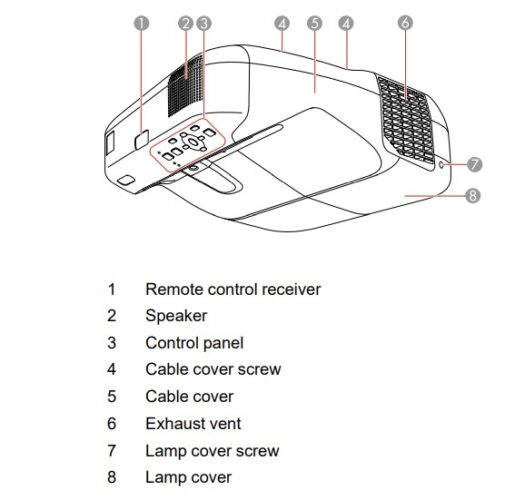
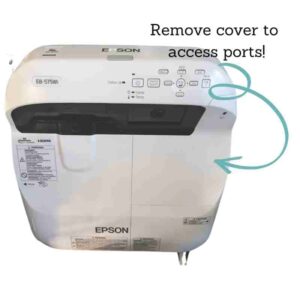
Step 2: Reset Projector to Default Settings
Second, reset your projector to factory settings.
How to Reset Epson Projectors
After buying a projector second-hand, one of the first things you should do it reset all the settings so you can have a fresh start! Don’t try holding onto someone else’s ideal settings of the perfect projector!
To reset, go to the Menu> Reset>Reset All. This will reset all of the projector values to their default setting.
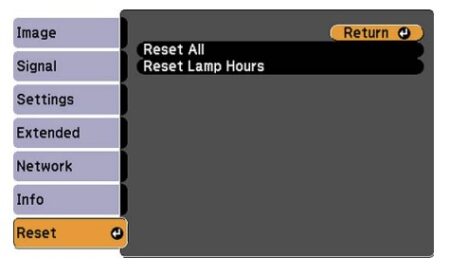
Step 3: Connect Your Projector to Your Computer
Third, connect your projector to your computer and install drivers as needed. The two main ways that we connect ultra-short throw projectors to your computer for pattern projecting is using the USB and HDMI ports. If you would like a wireless connection, you will need a device such as a Google Chromecast to make your projector wireless capable.

How to Connect Using USB Ports and Install USB Display Driver
To connect using USB: Install the USB driver onto your computer. You will need the driver that is related to your specific operating system. Then, connect by plugging in the USB-B to the projector and the USB-A side to the computer. Mac computers will often need a USB A to USB C (mini) adapter. Check if your computer has the regular-sides USB A ports or if they look smaller (USB C).
- USB Display Driver for Windows: https://epson.com/Support/wa00790a
- USB Display Driver for Mac: https://epson.com/Support/wa00790c
If the above display driver for doesn’t work for you, then use this link to search your specific projector. Type in the projector model name. The “Downloads” tab will appear. Find where is says “Operating System”. It should automatically detect your system. Just double check that it is correct. Then under Utilities, find the USB Display Driver. Click the blue “Download” button.
How to Connect Using HDMI Ports
To connect using HDMI, plug the HDMI cable into the projector then into the computer. It you are on a Mac, you may only have mini-HDMI ports. You will need to connect using an adapter.
How to Connect Using Chromecast
Chromecast can turn any device into a wireless display. This means that you can connect your computer or laptop to a Chromecast device and wirelessly project to your projector.
This is a great option for projectors that are not Wi-Fi enabled. This will turn any HDMI port (other adapters can be purchased) into a wireless display receiver. To see how to set up a Chromecast, watch the video below.
Step 4: Display Computer Screen on Projector
Fourth, display your computer screen through your projector by choosing the correct source on the projector and turning on “mirror display” as needed.
How to Display Your Computer Screen Through Your Projector
Using the Source Search button on the projector or remote, you can cycle through the source options until your image appears. On the remote you can also choose computer, video, or USB. If you connected your computer using a USB port, then choose USB. If you connected using HDMI, then select “Video”.
Trouble Shooting: If your Computer Screen does not display on the Projector, then try a solution below.
For PCs, try holding the Fn key and press the key labelled with the monitor icon. It has a picture of a computer pointing to another screen. You can press this again to display on both screens.
For Macs, you need to setup for a mirrored display. Select the Apple logo for the menu. Choose System Preferences>Displays>Arrangement>Mirror Displays.
Step 5: Prepare to Calibrate by “Mounting” Your Projector
Next, you will be placing your ultra-short throw projector next to your cutting space. I put “mounting” in quotations because everyone’s setup is different. Some stack the projector on a chair and books next to the table. Others put the projector on a shelf by the cutting area. Another way to “mount” is to use monitor mounts, TV stands, and rolling carts. Take a look at the Gallery page or How to Mount Your Projector for Sewing for more ideas! The plans for a DIY adjustable shelf for your UST projector will make calibrating your projector a little bit easier. Scroll down in the article linked above to find the download link to the free plans.
Step 6: Adjust Image Size and Orientation
While you are “mounting” your ultra-short throw projector, raise and lower the projector until you are happy with the size of the image. Do this with the projector on. You will not be able to adjust the height later without messing up your calibration. Anytime your projector is moved up or down after calibration will require you to “re-calibrate”.
It is okay if the image is larger than your cutting area or spills over the edge of the table. The only time this will affect the sewing is if a pattern doesn’t have enough “white space” for you to scroll the pattern where you need. So, try not to have the image vastly larger than your cutting area, but a little bigger is okay.
You cannot rotate the image. The projector should be placed on the long side of the table to take advantage of the entire width of the projection.
Epson projectors do have an adjust image position feature. This will “shift” the image to a corner or center as needed. I recommend only using this feature if the image is really not working for your cutting area.
Adjusting Image Position
Adjusting the image position can help shift the image to place it on your cutting surface. Physical adjustment of the projector is the best way to do this, but minor adjustments can be made here if necessary.
With the projector on, you can adjust the size of the image using the Wide and Tele buttons. After adjusting the image size, the image shift screen will automatically appear. You can use the arrow buttons on the projector or remote to change the image position.
Image shift can also be used on the Epson ultra-short throw projectors to shift the image closer to or farther away from the projector.
Make the Image Right-Side Up
During the initial setup of your projector, you will want to setup the image so that it is right-side up. To change the projection mode (how the screen is facing) on the remote, press and hold the AV/Mute button for 5 seconds. This will only flip the image top to bottom. Repeat holding the AV/Mute button to return to its original orientation.
On the projector press Menu>Extended>ENTER. Choose the “Projection” and press ENTER. Chose a projection orientation and press ENTER. Do this until the image appears correctly for you. Then, press Esc to exit the menu.
Step 7: Open Calibration Document and Focus Image
Next, open the calibration document in Adobe Reader. It is best if you can go to full screen mode by pressing CTR+L (Windows) or Command + L (Mac). Make sure you have followed the steps in preparing for calibration to change the preferences when going to full screen in Adobe.
Use the focus lever on the projector to focus the image.
Focusing an Epson Ultra-Short Throw Projector
Finding the focus button on an UST projector can be tricky at first. I feel like it is in a kind of weird position. You will need to flip up the panel where the air filter is. Next to the filters (which should be vacuum dusted from time to time) is a slide level. Moving this level up and down will focus the projector image.
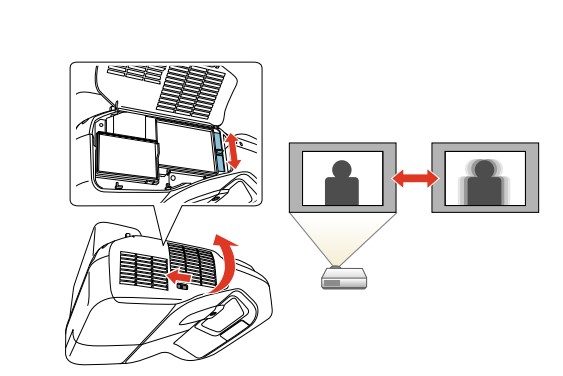
Step 8: Square Image with Physical Tilts and Adjustments
Look at the projected image. You don’t need to have the calibration document, but you can if you want. Just remember to focus on the outer corners of the projected image and not the squares yet!
*You will probably need to go back and forth between step 8 and 9 a few times to get the calibration just right. These are the longest steps! It is okay to step back and come back later if it is taking a long time!
You don’t want your image to be a trapezoid in any way. Tilt the projector up/down and left/right to see how the image changes. Adjust the tilt of the projector so the right and left edges are parallel to each other. This is usually achieved when the ultra-short throw projector is pointing directly in the center of the image.
Tilt the projector forward and backward to try to get square corners. Use a notecard or piece of paper to check the corners. If you do not have an adjustable shelf for your projector, then you will need to use folded up pieces of paper or cardstock to stuff under the corners and bottom of the projector to get a square image.
Keystone adjustment can be used in this step, but physically tilting is much better. The keystone buttons are found on the projector. Using keystone can cause the image to degrade.
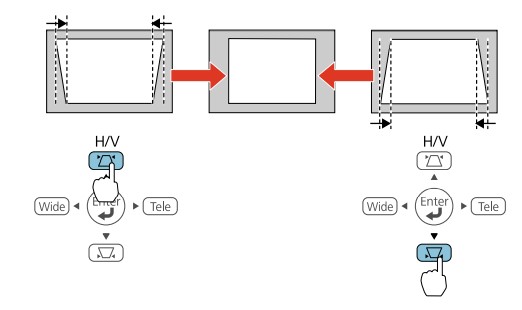
Resource: Use this illustration by Dan Oen to figure out how to tilt the projector. Here is a link to the picture so you can zoom in!
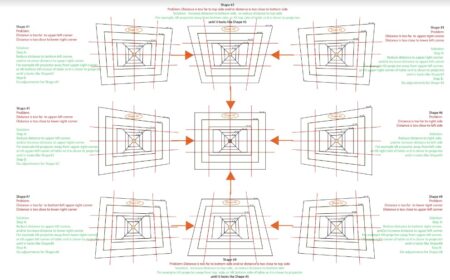
If you are very close to having square corners, another trick to use is the “quick corner adjustment” feature on Epson UST projectors.
Quick Corner Adjustment
A quick corner adjustment can be made if you have made physical adjustments to your projector and you are very close to calibration. Quick corner adjustment can cause image degradation, so only use it for minor adjustments.
To access Quick Corners on your projector go to the menu Settings>Keystone>Quick Corners. You will see a quick corners menu appear.
You will adjust one corner at a time. Select one corner to start with using the arrow keys and press Enter. Press the arrow buttons to adjust the corner image shape until the corner is completely square.
Repeat with all corners. When you are finished, press Esc.
If you are close to having square corners then go onto the next step. You can continue to do physical tilts and adjustments to fine tune the image when the zoom is close!
Step 9: Zoom in Adobe
Once you have a square image (or are close to it), then you can adjust the zoom on your computer in Adobe. Open the calibration document linked above. Open it in Adobe Reader DC and go to full screen mode by pressing CTR+L (Windows) or Command +L (Mac). If you have already setup your Adobe preferences, your zoom percentage will not change when you go to full screen mode.
*You can use a PDF reader such as Xodo on mobile devices to adjust zoom using fingers.
Zoom can be adjusted in Adobe using Control Y (Windows) or Command Y (Macs). Then, you can adjust by typing in down to 0.1% zoom.
Align the projected calibration document to your cutting mat grid by centering the image on your cutting surface and physically moving your cutting mat.
Start by aligning the red horizontal/vertical and black diagonal lines.
Next, adjust the zoom so that the inner 1 inch squares match the squares on your mat. Center your image on the middle squares in the calibration document. Then move your mat to match the center of the image. The vertical and horizontal lines should line up with your mat.
Do the red horizontal/vertical and black diagonal lines match up correctly?
No-Then you need to make some more physical tilts and adjustments to the projector.
Yes-Continue adjusting the zoom in Adobe.
HELP-My squares are rectangles! This means you have an aspect ratio issue. Look at “Changing the Aspect Ratio” below.
Focus on the largest box that you can see on your projected image. Zoom in until the largest box measures correctly. When the largest box measures correctly, ALL of the smaller box will too!
*Many people wonder where to measure the lines of the boxes from. The lines should be measured from the center of each line.
Your goal is to be within 99% accuracy. Remember sometimes it is better to be “close” and finished, then to continue fussing! I promise it will still be more accurate than cutting an taping patterns!
Check the boxes on the calibration document with your tape measure to ensure accuracy.
Troubleshooting Tip: You may need to still make minor keystone/tilt adjustments so everything lines up.
Troubleshooting Tip: If your “squares” are “rectangles”, then you have an aspect ratio or display resolution issue.
Changing the Aspect Ratio of Your Epson Projector
The most common and correct aspect ratio to use on your projector is “Auto” or “Native”. Often your projector will use the correct aspect ratio when it is plugged into the computer. On rare occasions, you may need to try different aspect ratios. Always make sure you have an aspect ratio issue (rectangles instead of squares) before changing! Often beginners think they have an aspect ratio issues, when really they need to tilt the projector forward or backward. This is indicated by the tops of the boxes being shorter or wider than the bottom of the boxes.
To change the aspect ratio on the remote, press the Aspect (8) button on the remote control. When presses, the shape and size of the image will change and the name of the aspect ratio appears briefly on the screen. Cycle through the choices by pressing the Aspect button again.
When connected using HDMI, you may also need to change the display resolution of your computer to match the projector. Espon UST projectors are most commonly 1024x768 or 1280x800. Mac HDMI adapters can sometimes create unsolvable aspect ratio issues. If you are connected this way, you may want to try switching to a USB connection using a USB A to USB B cable. You will also need to install a driver to use the USB connection.
HELP ME!!
If you are still having a hard time getting your projector calibrated, take a picture of your entire cutting surface with the calibration document. Then, head over to the Projectors For Sewing Facebook page. Post your picture, what projector you are using, and how you are connecting. Members of the group will help you trouble shoot and give you tips on getting calibrated.
You can even book a 1-on-1 with Missy Pore for calibration help.
Step 10: Note Zoom % and Record Calibration
Once everything matches with 99% accuracy, you are calibrated! If your outer lines (largest boxes) are still 1/8 in off, you are within the accuracy needed!
Make note and record the calibration number. For example, my zoom is calibrated at 33.7% in Adobe. (Everyone’s is unique, so don’t use mine!) Write this down and SAVE it somewhere you can easily find it. Just stick it to the projector or wall!
Next time you open a projector pattern file or A0 file for sewing, zoom into your “calibrated zoom”. You cannot use this calibrated zoom on different programs. In other words, Adobe may have a different zoom percentage than Affinity Designer.
Ready to Cut!
Jump for joy! Do a little dance! You did it!
Maintenance of Your Projector
Nobody likes more chores, but this is one you don’t want to skip! Remember to clean your projector often for optimal performance. Here are some great tips for cleaning the ultra-short throw projectors for sewing.
How to clean and maintain your projector
To keep your projector running efficiently, I highly recommend a little maintenance from time-to-time. Clean the air filter and air vents periodically to keep them dust-free and prevent overheating due to blocked ventilation. A small vacuum or paint brush often works well.
With a clean microfiber cloth or lens-cleaning paper, gently wipe the projection window and obstacle sensor.
Dust the entire unit with a dry, lint-free cloth. Never use a spray cleaner. If needed, you can use a moistened cloth with water and mild soap.
If your lamp hours are running high and you need a replacement, you can also purchase new bulbs. New air filters can be purchased as well as needed.
If the projector’s lamp light is flashing orange, then it’s time to replace it. Other indicators are a message appears saying to replace the lamp or the image is darker and starts to deteriorate.
*A flashing red light on the projector usually means that the projector is too hot. Check that the air filters are not blocked. Here are some of the other issues indicated.
Conclusion
You have learned to calibrate an ultra-short throw projector and are now ready to cut your first pattern! I suggest starting with a pattern that has a dedicated projector file. Here are 17 free sewing patterns with projector files to get you started!
Now you are on your way to opening up a whole new world of sewing! Congratulations!
